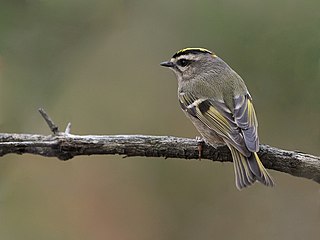
Pallas's leaf warbler or Pallas's warbler, is a bird that breeds in mountain forests from southern Siberia east to northern Mongolia and northeast China. It is named for German zoologist Peter Simon Pallas, who first formally described it. This leaf warbler is strongly migratory, wintering mainly in south China and adjacent areas of southeast Asia, although in recent decades increasing numbers have been found in Europe in autumn.

The golden-crowned kinglet is a very small songbird in the family Regulidae that lives throughout much of North America.

The yellow-throated warbler is a small migratory songbird species in the New World warbler family (Parulidae) found in temperate North America.

The boat-billed flycatcher is a passerine bird. It is a large tyrant flycatcher, the only member of the monotypic genus Megarynchus.

The rufous-browed peppershrike is a passerine bird in the vireo family. It is widespread and often common in woodland, forest edge, and cultivation with some tall trees from Mexico and Trinidad south to Argentina and Uruguay.

The stripe-breasted spinetail is a passerine bird in the Furnariinae subfamily of the ovenbird family Furnariidae. It is found in Colombia, Trinidad, Tobago, and Venezuela.

The gray-headed kite is a raptor found in open woodland and swamp forests. It shares the genus Leptodon with the extremely rare white-collared kite. It breeds from eastern Mexico and Trinidad south to Peru, Bolivia, Brazil and northern Argentina.

The slaty-capped flycatcher is a small passerine bird in the tyrant flycatcher family. It is found in northern Bolivia to Costa Rica and in Trinidad.

The forest elaenia is a small passerine bird in the tyrant flycatcher family. It breeds from Panama through Colombia, Venezuela and the Guianas to Bolivia and Brazil. It also occurs on Trinidad.

The Madeira firecrest, Madeira kinglet, or Madeiracrest is a very small passerine bird endemic to the island of Madeira. It is a member of the kinglet family. Before it was recognised as a separate species in 2003, it was classified as a subspecies of the common firecrest. It differs in appearance and vocalisations from its relative, and genetic analysis has confirmed it as a different species. The Madeiran bird has green upperparts, whitish underparts and two white wingbars, and a distinctive head pattern with a black eye stripe, short white supercilium, and a crest that is mainly orange in the male and yellow in the female.

The grey-capped flycatcher is a passerine bird, a member of the large tyrant flycatcher family.

Myiozetetes is a small genus of passerine birds in the tyrant flycatcher family. The four species occur in tropical Central and South America.

The rufous-capped warbler is a New World warbler native from Mexico south to Guatemala, rarely occurring as far north as southeastern Arizona and south Texas. Birds in the southern part of the range are now split out as a separate species, as the chestnut-capped warbler.

The black-cheeked warbler is a New World warbler, resident breeding bird endemic to the Talamancan montane forests of Costa Rica and western Panama.

Basileuterus is a genus of New World warblers, best represented in Central and South America. This is one of only two warbler genera that are well represented in the latter continent. Some species formerly considered in this genus are now placed in the genus Myiothlypis. It is likely that the ancestors of this genus colonised South America from the family's heartland in northern Central America even before the two continents were linked, and subsequent speciation provided most of the resident warbler species of that region.

The russet antshrike is a passerine bird in the antbird family.

The white-eared ground sparrow is a large American sparrow which occurs locally in Middle America, mostly in foothills, from southern Mexico and Guatemala to northern Costa Rica.

Whitestarts are New World warblers in the genus Myioborus. The English name refers to the white outer tail feathers which are a prominent feature of the members of this genus. The species in this genus are also often called "redstarts".

The Bornean stubtail is a species of bird in the cettiid warbler family Cettiidae. It is endemic to the island of Borneo, where it inhabits forest floors and undergrowth in montane forests at elevations of 750–3,150 m (2,460–10,330 ft). It is a small, short-tailed warbler, measuring 9.5–10 cm (3.7–3.9 in) in length and having an average mass of 10.4 g (0.37 oz). The tops of the head and the upperparts are brown, with whitish underparts that turn grey at the sides of the breast and the flanks. The supercilium is long and buffish-brown, with an equally long dark grey eyestripe and a thin yellow eye-ring. Both sexes are similar.

The Roraiman warbler is a species of passerine bird in the new world warbler family Parulidae. It is known to associate with Tepui rainforest ecosystems and is found in southern Venezuela, western Guyana, and adjacent areas of northern Brazil. The bird has been periodically granted full species status, although it has also been occasionally considered a subspecies of two-banded warbler. Based on the population's physically disparate distance from the nominate species, vocal differences, and slight differences in plumage, several authorities consider the Roraiman warbler independent. Recent genetic evidence also indicates the birds of northern South America are significantly diverged from the two-banded warbler populations in the Andes.






















